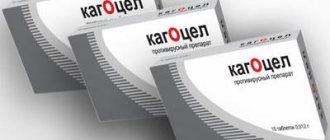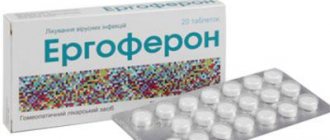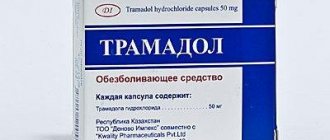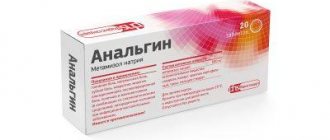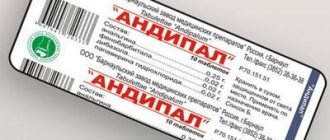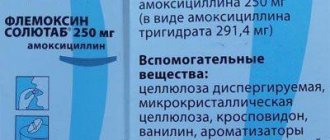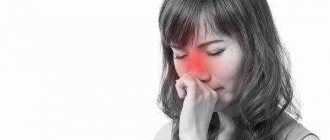We always have first aid medications at hand, which include Nurofen. When an inflammatory process occurs, the temperature rises or pain appears, we turn to rescue pills. Despite the fact that Nurofen can help relieve the symptoms of various diseases, it can also lead to side effects. Especially if you take the drug in larger doses than necessary. This leads to intoxication of the body and requires quick help.
Pathogenesis
Prostaglandins are involved in a number of physiological processes. Side effects of Nurofen during therapeutic use (irritation of the gastrointestinal tract, decreased renal blood flow, impaired platelet function) are due to its ability to suppress the synthesis of prostaglandins. The mechanism of the toxic effect of doses of the drug in an overdose of Nurofen, significantly exceeding therapeutic doses, has not been sufficiently studied. In children, doses of less than 100 mg/kg have no toxic effect; doses of more than 400 mg/kg cause severe poisoning with coma and convulsions.
Release form, composition and packaging
Oral suspension (orange) white or almost white in color, syrupy consistency, with a characteristic orange odor.
| 5 ml | |
| ibuprofen | 100 mg |
Excipients: maltitol syrup, water, glycerol, citric acid, sodium citrate, sodium chloride, sodium saccharinate, orange flavor 2M16014, xanthan gum, polysorbate 80, domiphene bromide.
100 ml - polyethylene bottles with a protective cap (1) complete with a 5 ml measuring syringe - cardboard packs.
Oral suspension (strawberry) is white or almost white in color, syrupy consistency, with a characteristic strawberry odor.
| 5 ml | |
| ibuprofen | 100 mg |
Excipients: maltitol syrup, water, glycerol, citric acid, sodium citrate, sodium chloride, sodium saccharinate, xanthan gum, strawberry flavor 500244E, polysorbate 80, domiphene bromide.
100 ml - polyethylene bottles with a protective cap (1) complete with a 5 ml measuring syringe - cardboard packs.
Symptoms of Nurofen overdose
The clinical picture of an overdose develops in the first 4 hours after taking the drug and resolves within 1 day. Nausea, vomiting occurs in the epigastric region, more or less severe drowsiness, ataxia. Rarely, metabolic acidosis with anion gap, coma, transient episodes of apnea, renal failure, drop in blood pressure, and convulsions are observed. In addition, nystagmus, diplopia, trismus, and transient deafness have been described.
The severity of the clinical manifestations of an overdose of Nurofen depends on its level in the blood, but the pattern of this dependence has been poorly studied, and there are no methods available in practice for determining the level of the drug in the blood. When taking large amounts of medication, it is necessary to monitor kidney function and acid-base status.
Drug interactions
With the simultaneous use of Nurofen for children and anticoagulants, the effect of the latter may be enhanced.
With the simultaneous use of Nurofen for children with diuretics and antihypertensive drugs, the effects of the latter may be weakened.
When used together, Nurofen® for children increases the side effects of mineralocorticoids and glucocorticoids.
When used together, Nurofen® for children increases the blood concentration of digoxin, phenytoin, methotrexate, and lithium.
Treatment of overdose with Nurofen
There is no antidote for Nurofen, so maintaining vital functions is critical. Emetics do not have a particularly beneficial effect. You can use activated carbon. The effectiveness of extracorporeal methods for removing Nurofen has not been sufficiently studied. They are not yet recommended.
More often than not, pain strikes at the most inopportune moment. The prerequisites for its manifestation are psychological stress, injuries, natural physiological processes, as well as diseases or disorders in the functioning of the human body. The best medication for effective pain relief is Nurofen.
The advantage of the drug is that it can be used by patients of all age categories. However, despite the wide range of indications for therapeutic use, there is a danger of developing the consequences of an overdose of Nurofen in children and adults.
Let's consider the main causes and symptoms of intoxication, as well as measures designed for its effective treatment and prevention.
Important to remember! If you experience minimal symptoms of Nurofen overdose, call emergency services immediately. Timely provision of assistance reduces the risk of developing dangerous consequences.
First aid and treatment
What to do in case of poisoning? It is necessary to stop the spread of the drug components through the circulatory system. Solutions based on salt and soda are suitable as an affordable solution. Then the gag reflex is provoked by pressing on the tip of the tongue.
Carefully ensure that no food particles come out along with the vomit. Afterwards, a sorbent agent is taken - activated carbon.
Severe consequences of an overdose will require the intervention of medical professionals. The following activities are carried out:
- Drip method (glucose, sodium bicarbonate);
- Hemodialysis (kidney cleansing);
- Ventilation of the lungs;
- Using medications to improve heart rhythm.
Helping a child
Carrying out measures to cleanse the body of the drug can be complicated by the age of children. You are advised to urgently contact a medical facility where qualified assistance will be provided. Doctors will insert a special tube into the baby for gastric lavage. Additionally, you will be prescribed to drink alkaline mineral water, alternating with taking diuretic medications.
Poisoning in a child usually occurs when he drinks 200 ml of syrup with a body weight of 10 kg. Many drugs from foreign manufacturers are provided with special protection mechanisms to prevent children from opening the bottle.
Actions at home:
- If you notice characteristic symptoms, rinse your mouth and throat using purified warm water.
- Provoke a gag reflex by pressing on the tip of the tongue.
- Provide a sorbent that is safe for children.
- Create a comfort zone (if it hurts your eyes, close the window with curtains).
- Prepare the necessary things and documents for inpatient hospitalization.
Recovery period
After carrying out the main treatment measures, you will need to create favorable conditions and choose the right diet. You are allowed to eat some foods:
- Freshly prepared vegetable dishes, excluding the use of plant products that can cause heaviness in the stomach and increased gas formation.
- Remove melons and melons containing a significant amount of liquid from fruit products.
- Suitable foods include rice, buckwheat, oatmeal and semolina porridge.
- Low fat kefir, fermented baked milk; milk porridge or cereal flakes with low-fat milk.
- Cookies in biscuits.
Natural juices diluted with water are suitable for drinking. Herbal decoctions are also allowed (pay attention to individual sensitivity to the components).
- Do not take more medicine than prescribed by your doctor (the dose is calculated according to the weight and severity of the disease).
- At the end of the expiration date, the drugs should be thrown away, as negative chemical reactions begin to occur over time.
- Do not use the product if the packaging is damaged (decomposition is occurring).
- Keep medications out of the reach of children and do not open the bottle in their presence.
Nurofen is able to relieve pain, which is why it is so in demand when painful sensations of various origins occur. The medicine is also characterized by toxic properties if the permissible dose of the drug is exceeded.
Following the doctor's recommendations will relieve pain, eliminate inflammation and reduce fever. Ignoring it leads to dire consequences.
Nurofen is used as a symptomatic treatment for pain, fever and inflammation. Depending on age and weight, the dosage is selected. An overdose of Nurofen is possible if the recommended amount of the drug is exceeded or if it is taken for a long time. The characteristics of adverse reactions and complications that develop vary individually. In any case, if you notice signs of poisoning in one of your family members, especially children, you should immediately stop taking the medicine and call a doctor.
Brief description of the drug
The drug Nurofen is available in the form of capsules, tablets, gel, as well as children's rectal suppositories and oral suspension. The medication contains ibuprofen, which is used as an active ingredient (see). Also in some types of the product codeine is added to enhance the therapeutic power.
Auxiliary components, as well as the dosage of the active substance, depend solely on the form of release of the medication.
Read what to do in case of: main manifestations and first aid.
Find out: causes, symptoms of overdose, first aid and treatment.
Nurofen has the ability to relieve pain, inflammatory processes of various origins, and also quickly reduce temperature and feelings of heat. When applying the medication in the form of a gel, local relief of unpleasant symptoms occurs. Ibuprofen, which is the active substance of the drug, inhibits the synthesis of prostaglandins, which cause all of the above symptoms.
Pharmacological action of the drug
Nurofen is capable of providing a rapid, targeted analgesic effect, as well as fighting fever and exhibiting anti-inflammatory properties.
The active substance of the drug in question, ibuprofen, is a derivative of propionic acid. Its principle of action is associated with inhibition of the synthesis of prostaglandins - mediators of inflammation, pain and hyperthermic reaction. The drug indiscriminately blocks COX-2 and COX-1, and also reversibly reduces the rate of platelet aggregation.
The analgesic effect after taking Nurofen lasts up to 8 hours.
Indications for use
Regardless of the form of release, the use of the drug is justified for the treatment of the following pathologies:
- pain syndrome of various nature;
- brachial plexopathy of an idiopathic nature;
- elevated temperature due to infectious diseases;
- gout;
- malignant tumors accompanied by pain;
- ankylosing spondylitis;
- various forms of arthritis.
Indications for the use of children's Nurofen in the form of a suspension or suppositories are:
- negative reactions to childhood vaccinations;
- pain of various origins;
- high temperature due to infectious lesions.
Side effects
Adverse reactions are manifestations of the consequences of an overdose of Nurofen. Their appearance is associated with the individual characteristics of the course of the disease and the patient’s body. In case of Nurofen poisoning, side effects increase many times over. Among them are:
- inflammatory processes in the pancreas;
- intestinal disorder;
- flatulence;
- pain in the mouth;
- increase or decrease in blood pressure;
- accelerated heart rate;
- feeling of heartburn;
- rapid weight loss;
- shortness of breath;
- nausea;
- depression;
- anemia (anemia);
- sleep disorders;
- hallucinations;
- bleeding of various nature;
- irritability;
- Quincke's edema;
- various allergic reactions on the skin.
Overdose
In the case of an incorrectly drawn up regimen for taking Nurofen, an overdose occurs quite often. The causes of poisoning in adult patients are not only single or systematic excesses of the norm of use, but also individual reactions to the action of the active components of the drug.
Children are more often at risk of developing intoxication. The reasons for an overdose of Nurofen in a child are:
- taking too much of the drug due to an incorrect dosage in relation to weight;
- use of a product with violated storage conditions or expired;
- keeping the medication in a place accessible to the baby;
- self-medication at home or ignoring the pediatrician’s instructions.
Remember! To avoid an overdose of Nurofen for children, be sure to consult a qualified pediatrician before using it.
Symptoms of intoxication
Symptoms of overdose in a child and an adult patient are largely the same and have the following character:
- nausea, frequent bouts of vomiting;
- tachycardia (rarely bradycardia);
- abdominal cramps;
- violation of movement coordination;
- a sharp decrease in blood pressure (down to critical levels);
- pressing headache;
- rash on the skin (mucous membranes);
- ringing in the ears and hallucinations;
- difficulty breathing;
- general feeling of weakness;
- renal failure;
- drowsiness;
- coma (rare).
Important! If you experience the slightest symptoms of an overdose of Nurofen for children, you should immediately call emergency medical help.
General information about the drug
Nurofen is a drug that has pronounced anti-inflammatory, antipyretic and analgesic properties. The active component of this product is ibuprofen. It belongs to the group of non-steroidal anti-inflammatory drugs and is actively used not only in the treatment of adult patients, but also in pediatric practice.
An overdose of Nurofen can occur when the recommended doses of the drug are intentionally or accidentally exceeded.
Consequences of intoxication
The main consequences of an overdose of Nurofen in children and adults are:
- chronic form of bronchitis;
- Gospel disease (jaundice);
- pancreatitis;
- diseases of the nervous system;
- acute and chronic disorders of the genitourinary system;
- decreased immunity.
Poisoning entails a number of serious consequences that lead to death. Timely assistance for intoxication reduces the risk of their occurrence.
Overdose treatment methods
The question of what to do in case of an overdose of Nurofen in a child or an adult interests all patients. First of all, you need to stop panicking and call emergency help: first aid.
Read in what cases: indications, dosages and side effects.
Prevention
To prevent a possible overdose of Nurofen for children or medication for adult patients, you must follow these rules:
- do not use the product that has expired;
- Avoid using medications with damaged packaging;
- do not change the dosage regimen prescribed by your doctor;
- keep the product away from children;
- do not let your child take the medicine himself;
- exclude home self-medication.
Conclusion
Nurofen has a strong analgesic property, the ability to relieve inflammation, as well as a feeling of heat. It is successfully used to treat children and adults. Systematic or accidental excess of the drug leads to the development of a number of dangerous pathologies due to an overdose.
Nurofen is the most popular drug that has an antipyretic and anti-inflammatory effect, but childhood poisoning with this drug is also possible.
Children's Nurofen is available in syrup and tablets
It is produced in the form of syrup, tablets, suppositories, and gels. But children's ones only come in syrups. It has an analgesic effect. Children's age for using this medicine is from 3 months to 12 years. To treat infectious diseases, after vaccinations, when teething, acute respiratory infections and acute respiratory viral infections. Like all medications, it has universal contraindications for liver, kidney and heart failure. And also for diseases of the stomach and blood. Use with caution during pregnancy and lactation.
Important! The instructions for use must be strictly followed. An overdose for children can be fatal.
The main component of this medication is ibuprofen. Auxiliary ingredients: dimofen bromite, polysorbate, chloride, saccharinate, glycerin, citric acid, water, flavorings 2M16014 or 500244E, maltitol syrup, glycerol, xanthan gum.
Consult a doctor before use
. The amount of medication is calculated based on the child’s body weight. For pain or fever, a single dose should be from 5 mg to 10 mg per kg. Taking into account the weight and age of the patient. Use no more than 4 times a day. Duration of use is 3 - 5 days. In case of heat and fever, use no more than 3 days. And with pain relief, no more than 5 days. The duration of action of one dose is 8 hours.
- From 3 to 6 months, 2.5 ml 3 times a day.
- From 6 to 12 months, 2.5 ml 3-4 times a day, but not to exceed 200 ml per day.
- From one to three years, 5.0 ml 3 times a day, the norm is 300 ml per day.
- From 4 to 6 years, 7.5 ml three times a day, the daily norm is 450 ml per day.
- From 7 to 9 years, 10 ml 3 times a day, no more than 600 ml per day.
- From 10 - 12 to 15 ml 3 times a day, not exceeding 900 ml per day.
It is advisable to take it during or after meals.
Use with caution with other drugs. Only with the consultation of a doctor. Compatibility with diuretics and antihypertensives reduces its effectiveness.
Nurofen and pregnancy
Pregnant women should avoid taking Nurofen
Every expectant mother is very careful about her health. After all, her health is the health of her baby. During such an important period, all women treat medications with fear and caution. The instructions that come with each bottle contain information by trimester.
Children's Nurofen during pregnancy:
- 1st and 2nd trimester. The use of the drug is possible if the benefit outweighs the risk for normal fetal development.
- 3rd trimester. Absolutely forbidden
. The components may cause premature birth.
You can take the drug while breastfeeding. But at the same time, it is necessary to stop feeding so as not to harm the baby’s health.
Limiting the use of the medicine
Age up to three months and body weight should be from 5 kg.
Syrup has many contraindications such as:
- Intolerance to the components included in the composition.
- For liver, kidney and heart failure.
- Nasal polyposis.
- Bronchial asthma.
- For blood diseases.
- Anemia.
- Intestinal diseases.
- For hypokalemia.
Side effects of Nurofen
To avoid side effects, you must strictly adhere to the instructions and recommendations of the doctor.
Various side effects:
- Vomiting, nausea, loose stools, pain in the animal.
- Bleeding in the gastrointestinal tract.
- Allergic reactions ranging from urticaria to Lyell's syndrome.
- Headache, overexcitement, nausea, dizziness.
- Insomnia.
- Renal dysfunction, inflammatory diseases of the bladder.
- Hepatitis.
- Rapid weight loss.
- Shortness of breath.
- Cystitis.
- Tachycardia.
- Increased pressure.
It is necessary to closely monitor the child’s behavior and his health. If you detect any signs, immediately contact an ambulance.
Giving children Nurofen or its analogues should be used for no more than 5 days. Because the body gets used to it very quickly.
Children's Nurofen is indicated for use as an antipyretic
Drug overdose in children
Important! If you take the medicine correctly, there will be no overdose. But if, nevertheless, there is an overdose, then you need to consult a doctor.
You can identify an overdose by the following symptoms:
- pallor,
- vomit,
- dizziness,
- pain in the stomach and ears,
- a sharp decrease in pressure,
- heart diseases,
- coma,
- heart failure,
- renal failure,
- bradycardia,
- metabolic acidosis.
It is best not to risk the health and life of the child.
First aid for overdose
The main thing is to act quickly without panic. The baby’s further well-being depends on the correct assistance provided. It is necessary to give the child warm, boiled water in small sips. Adult children (over 5 years old) are induced to vomit to rid the body of the drug.
Important! Small babies should not be vomited.
Parents should strictly follow the instructions and not exceed the dosage
Then take the sorbent and wait for specialists. The child should be given a compress (of cool water) and allowed to rest. At this time, parents must collect all the necessary things for hospitalization. For complex symptoms, self-medication at home will not help.
- When buying a drug at a pharmacy, you need to pay attention to the date of manufacture and expiration date.
- Do not exceed the dose without consulting a doctor. Take as directed.
- If you need to take other medications, you first need to find out about compatibility.
- Important! Store syrup correctly.
- If for some reason the stage is clear that the medication is not suitable for the baby. You must stop using it immediately. Children's poisoning with Nurofen is very rare. Even less often - in severe form. You need to take your medication seriously. The responsibility and prudence of parents is, first of all, the health and long life of their children.
Video
How to properly give Nurofen to a child? Review of the drug in syrup - how to use the dispenser and how to determine the dose.
Nurofen for children is prescribed to be taken from three months to 12 years. It is produced in the form of a suspension with a pleasant fruity taste. The medicine is used during infectious diseases as an anesthetic and to reduce fever after preventive vaccinations. Pediatricians can prescribe this drug for other diseases, making sure to calculate the correct dosage; in this case, it is not considered dangerous. An overdose of Nurofen in a child leads to severe poisoning and can be fatal.
What is Nurofen?
Nurofen is a drug, a representative of the group of non-steroidal anti-inflammatory drugs. Its action is aimed at relieving inflammation, reducing fever and pain relief. It is available under different names and in various forms, among which there are the following types:
- pills,
- effervescent tablets,
- lozenges,
- suspensions,
- capsules,
- candles,
- gels for external use.
Nurofen is available for children and adults. Children's Nurofen is made in the form of suspensions or syrups, as well as suppositories. It can be taken by children from three months.
This drug usually contains ibuprofen in varying amounts. Ibuprofen itself has an antipyretic and analgesic effect on the body. This remedy is one of the most important medicines of the World Health Organization, as its effectiveness has been proven. Nurofen, which also contains codeine, has the most powerful analgesic effect. This component is an opium alkaloid with a pronounced antitussive effect. Such varieties contribute to the most correct selection of a drug for the symptomatic treatment of certain diseases.
Nurofen is used to relieve symptoms of the following diseases:
- ORZ,
- ARVI,
- flu,
- toothache,
- headache,
- pain in muscles and joints,
- menstrual pain,
- a sore throat,
- migraine,
- neuralgia,
- injury to muscles and ligaments,
- sports injury.
The action of Nurofen in the body occurs by blocking the work of biologically active substances that lead to inflammation, fever and pain syndromes. It relieves these symptoms by interfering with the body's production of substances such as prostaglandins, which cause pain, tissue inflammation and fever either in the injured area or throughout the body.
Nurofen can be taken in three ways:
- ingestion (when we take medicine),
- rectally (through the rectum),
- locally (by applying gel to the affected area).
The first two methods contribute to the effect of the drug in all inflamed or painful tissues and organs, reducing temperature throughout the body. Gels that are applied only to the affected areas of the skin relieve symptoms only in that skin and the tissues underneath it.
Causes of overdose
There are few causes of overdose and they all depend on adults.
- Incorrectly calculated dose relative to the baby's weight. This often happens when the weight is pretended by eye. It is advisable to weigh children before prescribing any medicine.
- The medicine was left in an accessible place, and the child was able to get it and drink it. The fault here lies with inattentive adults.
- Self-medication. The parents did not want to see a doctor and are giving the drug in the dosage specified in the instructions. The instructions most often indicate age, but not weight, which varies among children.
If there is any doubt about the dosage of the medication, you need to ask your doctor again!
Possible side effects from taking Nurofen
This drug, prescribed to children of different age groups, can cause a lot of side effects, which are listed below.
- Bloating with symptoms of flatulence.
- Severe weight loss (anorexia). This occurs due to a persistent decrease in appetite.
- Gastrointestinal tract disorders.
- Bleeding of various etiologies.
- Malfunctions of the pancreas.
- Impaired liver function with manifestations of jaundice.
- Inflammation of the oral mucosa.
- Migraine.
- Persistent hallucinations.
- Disturbances in the functioning of the nervous system.
- Depressive states.
- Insomnia.
- Instability of blood pressure.
- Anemia.
- Severe allergic reactions, sometimes with Quincke's edema.
An impressive list of adverse reactions does not mean that any disorder will necessarily manifest itself in an individual child. When taken correctly, children's Nurofen has a therapeutic effect.
Symptoms of Nurofen overdose
If an overdose of Nurofen occurs, the first symptoms may appear immediately or after some time. In any case, adults are required to quickly call a doctor or take the baby to a medical facility. Symptoms of poisoning look like this:
- spasmodic pain in the abdominal cavity, the child literally writhes in pain;
- feeling of nausea with strong salivation;
- vomit. Often, vomiting from Nurofen can be a sign of an allergic reaction in the body;
- general weakness;
- tinnitus and severe migraines;
- reduction in blood pressure to critical levels;
- cardiopalmus;
- malfunctions of the respiratory system;
- rashes on the skin and mucous membranes;
- falling into a coma;
- persistent renal failure.
If a child shows signs of an overdose of Nurofen, you should urgently call a doctor!
Emergency care for drug overdose
First aid for an overdose of Nurofen in children is very important, since all the medicine will not have time to be absorbed into the bloodstream. First, parents need to stop panicking. Not only the health, but also the life of the child will depend on quick and coordinated actions. The algorithm of actions is listed below.
- The child needs to quickly rinse his mouth and throat. To do this, use clean water at room temperature.
- If a child over five years of age is affected, vomiting can be artificially induced so that at least part of the medicine comes out. For this purpose, press on the root of the tongue with a spoon or finger. After this, any adsorbent is given that neutralizes toxic substances.
For children under three years of age, inducing vomiting before the ambulance arrives is strictly prohibited.
- The child is provided with complete rest. Place him in bed with his head turned slightly. If the victim has a headache and eyes, then curtain the windows.
- While waiting for the doctor to arrive, you need to collect the baby’s things and documents that may be useful in the hospital.
Therapy for excessive consumption of the drug is systematic, more aimed at stabilizing the functioning of the cardiovascular system.
Video
Watch a video about the negative effects of Nurofen on the cardiovascular system.
| COPPER PLATE | KUZNETSOV'S PLATE | ||
| ASHTRAY | CUP | FRUIT BOWL | ICON |
| IRON | INKWELL | BOX | OAK TASH |
It is not entirely true to say that only when we reach a certain age we are literally “covered by a wave of nostalgia” when we hear the melody of our youth or see some attributes of that time. Even a very small child begins to yearn for his favorite toy if someone took it away or hid it. We are all, to some extent, in love with old things, because they contain the spirit of an entire era. It is not enough for us to read about this in books or on the Internet. We want to have a real antique thing that we can touch and smell. Just remember your feelings when you picked up a Soviet-era book with slightly yellowed pages that emitted a sweetish aroma, especially when flipping through them, or when you looked at black and white photographs of your parents or grandparents, the same ones with an uneven white border. By the way, for many, such shots remain the most beloved to this day, despite the low quality of such images. The point here is not in the image, but in the feeling of spiritual warmth that fills us when they catch our eye.
If there are no “objects from the past” left in our lives due to endless moves and changes of place of residence, then you can buy antiques in our antique online store
. Antique stores are especially popular now, because not everyone has the opportunity to visit such outlets, and they are concentrated mainly only in large cities.
Recovery of a child after an overdose
After treatment of a drug overdose, a child may have a long rehabilitation period. At this time, it is important to provide the baby with peace and balanced nutrition. Such products should be present in the diet.
- seasonal vegetables, fresh and cooked. You should avoid vegetables that cause heaviness in the stomach or flatulence;
- fruits and berries. Apples, bananas, apricots, cherries in any form. You should not use melons, as they are too watery and difficult to digest;
- cereals – rice, buckwheat, oatmeal, semolina;
- fermented milk products – low-fat kefir or fermented baked milk. You can offer your child milk porridge with low-fat milk or cereal flakes with milk;
- biscuits or crackers made from day-old bread.
After poisoning, children need to be provided with a good drinking regime. Not only clean water is given as drinking water, but also various decoctions. Kids enjoy drinking fresh fruit juices diluted half and half with water. Juices supply vitamins and minerals to the children's body.
Nurofen in tablet form
The tablet form of the drug is used for children who have reached 6 years of age. You should not give the drug in this form to younger children, since the content of ibuprofen in it is higher, and if the tablet is swallowed, the child may choke. Adults can also take the tablets.
The Nurofen package contains instructions for use of the tablets, which are coated with a special coating. They can be placed in 6 pieces. on a blister, or maybe 12. The maximum number of tablets in a package can reach 96 pieces.
The product should be stored in a cool place where the temperature can vary from 15 to 25 degrees. It is valid for no more than 3 years. The drug should be stored in places where children's hands are not accessible.
Starting from 6 years of age, children are recommended to take no more than 1 tablet 4 times a day, but only under the supervision of a physician. For severe pain that is difficult to tolerate, children 12 years of age and older can increase the dosage to 2 tablets. The daily maximum for a child is 3 tablets (800 mg). The course lasts several days.
Consequences of Nurofen poisoning
The consequences of an overdose of Nurofen can be very serious, especially if the person has taken too much. Acute poisoning can affect all important organs and systems.
The following diseases may appear:
- chronic jaundice;
- chronic pancreatitis;
- disruption of the genitourinary system;
- diseases of the nervous system;
- persistent allergic reactions;
- Chronical bronchitis.
But it is worth noting that Nurofen is harmful only in excess quantities. If the dose is correctly calculated, then it has excellent anti-inflammatory and antipyretic properties.
Is it possible to use Nurofen during pregnancy?
Nurofen should not be taken during late pregnancy
Nurofen is one of the most popular drugs due to its effectiveness, and many women, having become pregnant, are interested in whether this medicine can be used while carrying a child.
According to the drug's annotation, it can only be used in the first and second trimester of pregnancy, and only in cases where the benefit from it outweighs the risk of the baby's development.
At a later date, it can affect the development of the fetus and provoke premature birth.
Taking Nurofen during lactation is contraindicated. If there is no choice, then you should stop feeding the drug for the duration of treatment, or give preference to other drugs, for example, Paracetamol or No-shpe.
Poisoning prevention
You can prevent intoxication of the body with medications if you follow a number of simple rules.
- Do not exceed the dosage recommended by the doctor. All medications are calculated strictly based on body weight and severity of the disease.
- Do not use medications that have expired. A chemical reaction occurs in them, and toxic substances appear.
- Do not use medications whose packaging is damaged. When exposed to air, some drugs tend to decompose.
- Medicines should be stored out of the reach of children. It is good to use a special medicine cabinet for this purpose, which is locked with a key.
- It is unacceptable to leave children's Nurofen on the table or chair until the next appointment. Many children cannot indifferently pass by a bright bottle, inside of which there is a sweet and tasty medicine.
- Children should not be shown how to open Nurofen bottles. This medicine is equipped with a special cap that opens only when pressed.
Nurofen is an excellent first aid remedy for a child with fever or severe pain of various types. But you should always remember that excessive and uncontrolled use of any medications leads to dire consequences.
Nurofen is a medication that has anti-inflammatory, analgesic and antipyretic effects. Its active component is ibuprofen, which belongs to the group of non-steroidal anti-inflammatory substances.
Mechanism of action of painkillers
Painkillers are presented in different groups, but in this article we are talking about those that you can easily buy at the pharmacy without a prescription - NSAIDs.
The spectrum of action of these drugs is associated with 4 pharmacological effects - antipyretic, analgesic, anti-inflammatory and blood thinning * - The difference in the strength and manifestation of these effects differs from drug to drug.
| Pharmacological effects of painkillers | |
| Anti-inflammatory | It appears within a few days. The development of the second and third phases of inflammation is limited. The maximum severity of the anti-inflammatory effect is found in pyrazolones (except analgin and amidopyrine) > salicylates (aspirin) > indoleacetic acid derivatives > phenylacetic acid derivatives > phenylpropionic acid derivatives (nurofen). |
| Analgesic (pain reliever) | Occurs within hours. If the pain is associated with a weak inflammatory reaction, use non-narcotic analgesics. Pain mediated by inflammation is affected by drugs with the most pronounced anti-inflammatory effects. |
| Antipyretic | In a few hours. If the patient does not tolerate a subfebrile temperature of 37-38 (the body's protective reaction due to increased activity of phagocytes and interferon production, increased release of lysosomal enzymes) - derivatives of aniline, salicylic, phenylacetic acids. In case of sudden changes in temperature during the day (hectic temperature) - analgin, amidopyrine. |
| Antiplatelet (blood thinning) | Aspirin has the greatest activity, irreversibly affecting platelet COX enzymes |
In 1971, J. Vane, J. Smith and A. Willis identified the mechanism of action of painkillers, which is associated with inhibition of the synthesis of COX (cyclooxygenase), a key enzyme in the metabolism of arachidonic acid. Arachidonic acid is a precursor of prostaglandins (PGs).
Almost all painkillers have a common mechanism of action. This means that having understood how Nurofen (ibuprofen) works, we will also understand the mechanism of action of other drugs in this group.
Analgesic
The main purpose of Nurofen is to reduce body temperature and eliminate inflammation. The analgesic effect of Nurofen is due to the similarity of the mechanism of development of spasmodic and inflammatory processes.
Indications
This remedy is prescribed not only to adults, but also to children from three months to 12 years of age. It is indicated in the treatment of infectious diseases, acute respiratory, acute respiratory viral diseases.
Childhood
Nurofen for children is also intended to eliminate pain in children during teething, during the period of unscheduled vaccinations.
For adults
The drug is most often prescribed to adults for:
- fever;
- infections;
- arthritis;
- articular attack (with gout);
- rheumatism;
- severe pain syndromes of various origins.
Contraindications
Having a wide spectrum of action, the drug has a number of contraindications. Among them:
- peptic ulcer of the stomach and duodenum
; - ulcerative colitis;
- heart failure;
- hypertonic disease.
It is prohibited to use the medicine in gel form if there are even minor skin lesions.
Side effects
The side effects of Nurofen are due to its property of inhibiting the synthesis of prostaglandins. Most often, Nurofen has a negative effect on children. It is expressed:
The list is impressive. However, when taken in accordance with medical recommendations, the medicine has a therapeutic effect.
When to use Nurofen for adults and children?
The action of Nurofen is aimed at symptomatic therapy. This drug does not fight the cause of the disease. Therefore, it is usually prescribed as an addition to other medications or procedures. This remedy is indicated for the following problems:
- types of arthritis,
- gout,
- ankylosing spondylitis,
- neuralgic amyotrophy,
- pain syndromes of different nature,
- postoperative pain,
- cancer pain,
- pain during the menstrual cycle,
- painful inflammation in the pelvic area,
- labor pains,
- threat of premature birth (stops uterine contractions),
- temperature during colds or infectious diseases.
Nurofen, taken orally, has this effect. The drug, which is applied to the skin, can be used for ligament damage, sports injuries, arthritis, neuralgia, back and muscle pain.
Nurofen, intended for children, helps reduce fever in young bodies with certain diseases:
- flu,
- ORZ,
- reactions after vaccinations,
- childhood infectious diseases.
It also acts as an analgesic for children with sore throats and ears, dental pain, headaches, migraines, neuralgia and post-traumatic symptoms in joints, bones, tendons, muscles and ligaments.
Areas where Nurofen has no effect are pain in the liver, spleen and digestive system.
Intoxication
The mechanisms of toxic effects in cases where an overdose of Nurofen has occurred (at excessively large doses) have not been sufficiently studied. Severe toxemia is rare. However, compliance with the recommended doses is desirable in any case, especially in children.
An overdose of Nurofen in a child is likely when taking more than 400 mg/kg. It can cause severe intoxication and coma, accompanied by convulsions.
A dose corresponding to less than 100 mg/kg will not cause harm to the child.
The maximum permissible daily doses correspond to 1.6-2.4 grams and 30 mg/kg for adults and children, respectively.
Symptoms
If the instructions for taking Nurofen are not followed and are excessively exceeded, the overdose will have symptoms depending on the degree of excess, as well as on the individual capabilities of the victim’s body.
Moderate
Basic symptoms for toxemia in mild and moderate forms:
Nausea, weakness, drowsiness with mild to moderate toxemia
- pain in the abdominal area;
- nausea accompanied by gag reflexes;
- general weakness, drowsiness;
- nystagmus;
- headaches and muscle pain;
- spasmodic phenomena in the masticatory muscles (trismus);
- ringing in the ears, intermittent changes in hearing;
- double vision;
- decreased blood pressure;
- bradycardia;
- tachycardia;
- depressive states.
Severe form
In severe form, the following development occurs:
- metabolic acidosis;
- acute renal failure;
- atrial fibrillation;
- coma
.
At what quantity and how do symptoms manifest?
According to the instructions, adults are allowed to consume 1.6-2.4 g of Nurofen per day. In children's practice (from 3 months, syrup, suppositories) no more than 30 mg per 1 kg of weight is allowed. Tablets can only be used from 6 years of age. For an overdose to occur, it is necessary to significantly exceed the amount recommended by the manufacturer. Symptoms of severe poisoning in children occur at a total daily dose of over 400 mg/kg. In adults, adverse reactions manifest themselves differently in each case.
Symptoms
A side effect may appear mainly after exceeding the daily dose for several days. In some cases, these phenomena may be immediate (with the development of an allergy to the components of the drug) or develop within a day.
The larger the amount of Nurofen taken over a long period of time, the stronger the severity of the overdose. Symptoms of an overdose of Nurofen in a child are similar in manifestations to adults. A more rapid and severe development of negative reactions is characteristic.
Side effects of Nurofen appear as:
- Dyspeptic symptoms: abdominal pain, nausea, vomiting;
- Signs of asthenia: lethargy, decreased mood, increased drowsiness;
- Headaches, nystagmus and double vision;
- Trismus of the muscles involved in chewing;
- Reversible negative reactions in the ears;
- Cardiovascular reactions: brady- or tachycardia.
Measures to eliminate symptoms
If you observe progressive symptoms of an overdose, it is necessary to take first aid measures by first calling a team of doctors. It is advisable to take the first measures before an hour has passed after taking the medicine.
Pre-medical actions
Gastric lavage will help remove undissolved medicine from the body.
The most important action is gastric lavage. It is necessary to drink 2-3 glasses of an aqueous solution of potassium permanganate and provoke a gag reflex. This will help remove undissolved medicine from the body.
The procedure should be repeated until the vomit is completely cleared.
Children are allowed to undergo the procedure if they are over 5 years old. In this case, the child must be placed comfortably on his side to eliminate the risk of choking on vomit.
Such procedures are not recommended for children under 3 years of age. Lavage for them is performed using a gastric tube in a hospital setting.
The next step is to take sorbent drugs. This is done to prevent further absorption of the substance into the bloodstream and the dynamics of toxemia.
Next, you need to ensure you drink plenty of fluids. For these purposes, it is advisable to prepare alkaline-mineral non-carbonated water with a pinch of soda or salt dissolved in it. This will reduce the percentage of the toxic substance in the bloodstream and speed up the process of eliminating it in the urine.
The victim should be wrapped in a blanket and a cool compress placed on the head.
Health care
Contacting a doctor if you take excessive doses of medication is necessary in any case. Especially if this happened to children, the elderly or pregnant women.
In an inpatient setting, the patient will continue treatment, which will consist of:
- Diuresis.
For these purposes, solutions of glucose, as well as sodium bicarbonate and electrolytes are poured in dropwise. The infusion is accompanied by the use of diuretics. - If necessary, hemodialysis is used.
There is no antidote for Nurofen.
When atrial fibrillation is observed, antiarrhythmic medications (amiodarone, procainamide) are infused. If there is no positive effect, an electrical defibrillation procedure is performed.
When is specialist help needed?
In all cases, in case of an overdose of NSAIDs, you should seek medical help, especially if an increased amount of medication was taken by a child, an elderly person or a pregnant woman.
To speed up the process of removing the drug from the human body, forced diuresis is performed, which involves alkalization of the plasma. To do this, intravenous infusion of electrolytes, glucose solutions and sodium bicarbonate is carried out. The patient may also be prescribed oral diuretics.
The use of other methods of extracorporeal detoxification is not provided due to their low efficiency.
